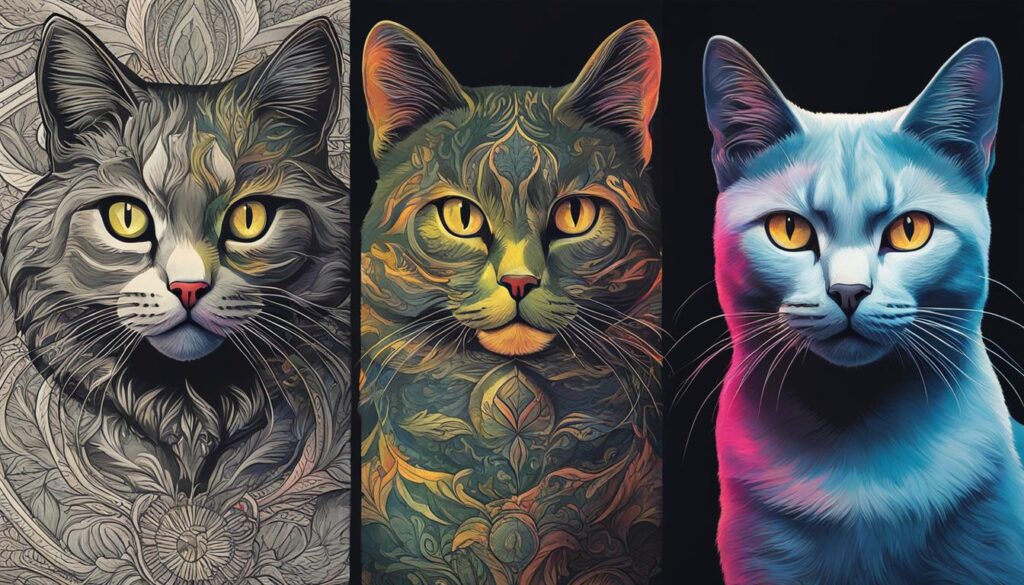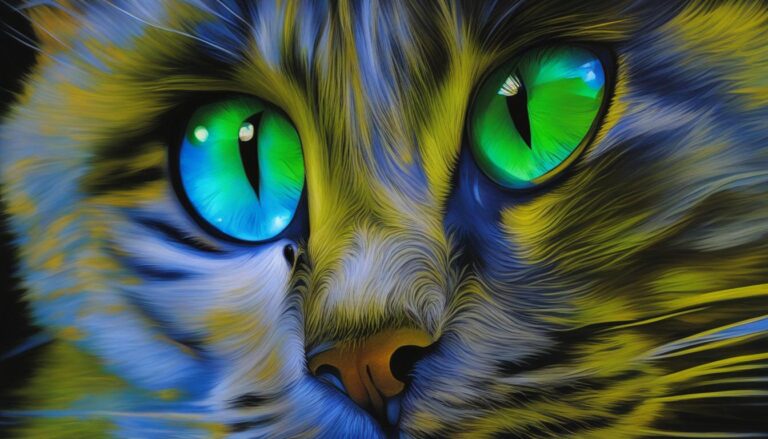Have you ever wondered if cats can see in the dark? It’s a common question among cat owners and feline enthusiasts. In this article, we will explore the fascinating world of cat vision in low light and uncover the secrets behind their remarkable feline night vision.
Key Takeaways:
- Cats have excellent night vision due to a higher number of rod cells in their eyes.
- The presence of the tapetum, a reflective layer of tissue, enhances their ability to see in dim light.
- Cats’ pupils can expand to allow more light into their eyes in low light situations.
- Cats’ night vision may be somewhat blurry, and they are near-sighted, struggling to see distant objects clearly.
- Cats are crepuscular animals, most active during twilight hours, rather than strictly nocturnal.
The Science Behind Cats’ Night Vision
When it comes to seeing in the dark, cats are truly remarkable creatures. Their ability to navigate low-light environments is a result of several fascinating elements of their visual system. One key factor is the presence of a specialized tissue called the tapetum lucidum. This reflective layer, located behind the retina, helps to maximize the use of available light by bouncing it back to the photoreceptor cells.
Another important component of cats’ night vision is their pupils. Unlike humans, who have round pupils, cats have vertical elliptical pupils that can expand and contract. In low-light situations, these pupils dilate to allow more light to enter the eye. This adaptation helps to improve their vision in dim lighting conditions. However, it’s important to note that while cats can see in the dark, their vision may be slightly blurry due to the elongated shape of their pupils.
“Cats’ night vision is truly fascinating. Their eyes have evolved to make the most out of minimal light, thanks to the tapetum lucidum and their unique pupils. It’s like having built-in night vision goggles!”
Additionally, cats have a wider field of vision compared to humans. While humans have a field of vision of approximately 180 degrees, cats can see up to 200 degrees. This wider peripheral vision allows them to detect movement and objects in their surroundings more effectively. Cats excel at tracking fast-moving prey and navigating in low-light environments, thanks to the combination of their high rod cell density, tapetum lucidum, and expansive field of vision.
| Aspect of Cat Vision | Description |
|---|---|
| Tapetum Lucidum | A reflective layer of tissue behind the retina that enhances night vision by reflecting light back to the photoreceptor cells |
| Pupils | Vertical elliptical pupils that dilate in low-light situations, allowing more light to enter the eye |
| Field of Vision | Cats have a wider field of vision compared to humans, allowing them to see up to 200 degrees |
The combination of these factors makes cats highly adapted to hunting and exploring in low-light conditions. Their incredible night vision capabilities, along with their other sensory abilities, such as their acute sense of hearing and smell, contribute to their success as crepuscular predators.
Cats’ Nocturnal Behavior Explained
Cats are fascinating creatures, and their nocturnal behavior is no exception. While they are not strictly nocturnal like owls or bats, cats are classified as crepuscular animals. This means that they are most active during the twilight hours of dawn and dusk. Understanding their activity patterns and behaviors during these times can help us better appreciate our feline friends.
So, what exactly drives cats to be more active at night? It’s a combination of factors, starting with their incredible senses. Cats have highly developed sensory abilities that allow them to navigate and hunt in low-light conditions. Their excellent sense of smell, which is more than 15 times stronger than ours, helps them detect prey even in the darkness. And let’s not forget their exceptional hearing, which allows them to pick up subtle sounds, like the scurrying of a mouse.
But it’s not just their senses that contribute to their nocturnal behavior. Cats also have a natural instinct to hunt, and the cover of darkness gives them an advantage over their prey. Their night vision, thanks to their specialized eyes, allows them to see in low light and spot movement easily. This combined with their stealth and agility makes them highly efficient hunters during the dark hours.
So, the next time you see your cat actively prowling in the evening or early morning, remember that it’s just their natural behavior. While they may enjoy a good nap during the day, they come alive when the sun goes down. Embrace their nocturnal tendencies and ensure they have plenty of opportunities for play and exercise during these times.
The Advantages of Crepuscular Behavior
Crepuscular behavior provides cats with distinct advantages. By being most active during the twilight hours, cats can avoid the intense heat of the day and the competition for resources that often occurs during daylight. This behavior also aligns with their evolutionary history as solitary hunters, allowing them to maximize their chances of catching prey and avoid encounters with potential predators.
| Advantages of Cats’ Crepuscular Behavior | |
|---|---|
| Maximizing prey opportunities | Cats’ hunting instincts are best suited for low-light conditions, increasing their chances of successful hunts. |
| Conserving energy | Being active during the cooler hours helps cats conserve energy by avoiding the heat of the day. |
| Avoiding competition | By being active when other potential predators are less active, cats can reduce competition for resources. |
| Staying safe | The cover of darkness provides cats with better camouflage and protection from predators. |
Comparing Cat Vision to Human Vision
When it comes to vision, cats and humans have distinct differences. While cats excel in certain areas, their visual abilities differ from those of humans in various ways.
Cats have a higher number of rod cells in their eyes, which enhances their night vision and enables them to detect motion effectively in low light conditions. However, they have fewer cone cells compared to humans, resulting in limited color vision. Cats primarily perceive shades of gray and have a reduced ability to distinguish between different colors.
In addition to their different cell composition, cats and humans also differ in terms of their field of vision. Cats have a wider field of vision, allowing them to see up to 200 degrees compared to our narrower field of approximately 180 degrees. This wider peripheral vision enables cats to detect movement and potential prey from various angles.
“Cats have a higher number of rod cells in their eyes, enhancing their night vision and enabling them to detect motion effectively in low light conditions.”
While cats excel in certain aspects, they do face challenges when it comes to long-distance vision. Cats are near-sighted, meaning they struggle to focus on distant objects. Their visual acuity for objects that are far away is not as sharp as that of humans.
| Aspect | Cats | Humans |
|---|---|---|
| Night Vision | High | Lower than cats |
| Color Vision | Limited | Full color spectrum |
| Field of Vision | Wider (up to 200 degrees) | Narrower (approximately 180 degrees) |
| Focus on Distant Objects | Challenges | Sharper visual acuity |
Understanding the differences between cat and human vision can help us appreciate the unique visual abilities of cats and provide appropriate care and environments that accommodate their specific needs.

Conclusion
In summary, cats possess remarkable night vision abilities that enable them to navigate in low light conditions. Their superior vision is due to the presence of a higher number of rod cells in their eyes, the reflective tapetum lucidum, and their ability to dilate their pupils. These factors work together to enhance their visual perception in dim environments.
While cats can see in the dark, their vision may not be as sharp as during daylight hours, resulting in slightly blurry images. Despite this, cats’ night vision, coupled with their other sensory abilities such as acute hearing and an exceptional sense of smell, equips them effectively for nighttime activities.
Although cats are not strictly nocturnal, they are most active during twilight hours as crepuscular animals. Their adaptive capabilities, including night vision, heightened sense of smell, and acute hearing, contribute to their hunting instincts and ability to explore and navigate in the dark.
Understanding the intricacies of a cat’s night vision can foster a deeper appreciation for their unique abilities. By providing a safe environment and ensuring appropriate care, you can support your feline companions in their exploration of low-light conditions without compromising their well-being.
Source Links
- https://www.hillspet.com/cat-care/behavior-appearance/can-cats-see-in-the-dark
- https://www.purina.co.uk/articles/cats/behaviour/common-questions/can-cats-see-in-the-dark
- https://www.dailypaws.com/cats-kittens/health-care/cat-conditions/can-cats-see-in-the-dark-how-a-cats-night-vision-differs-from-humans




